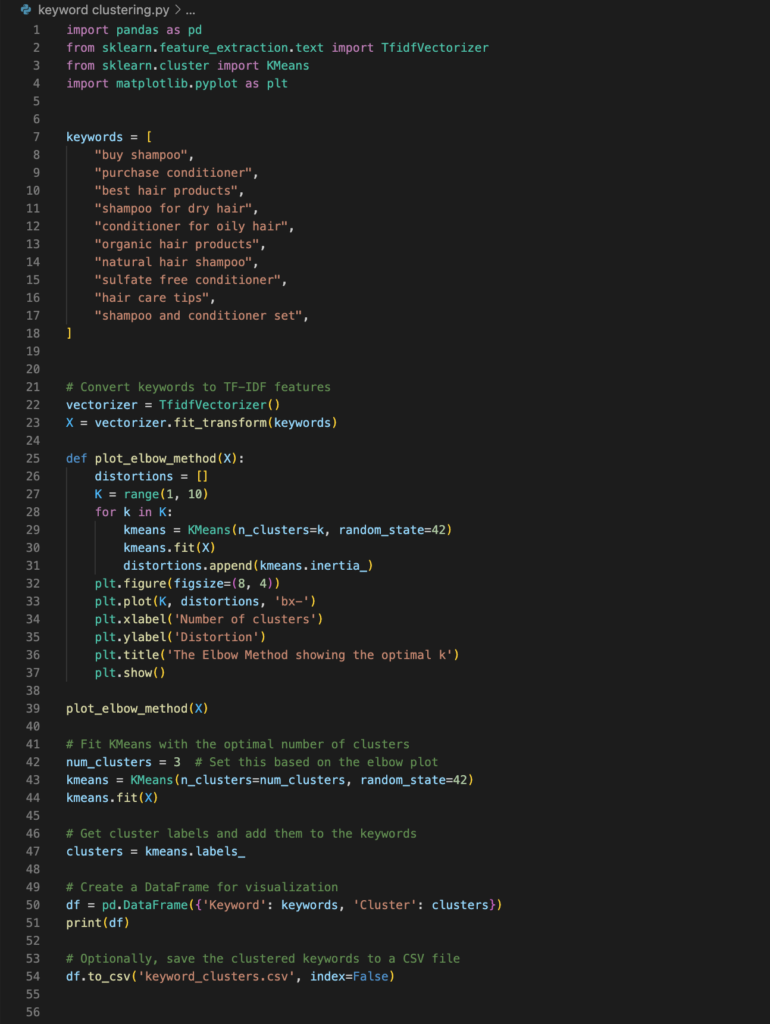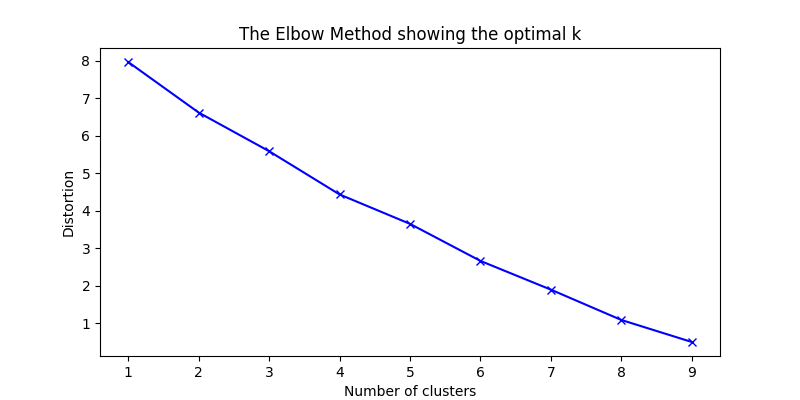Keyword clustering Python practice is crucial for effective Semantic SEO, as it helps group related keywords into coherent clusters, enhancing the relevancy and context of your content. By organizing keywords into clusters, you ensure that your content comprehensively covers a topic, catering to various search intents. This not only improves user experience but also signals to search engines that your content is authoritative and relevant. Implementing keyword clustering in your SEO strategy allows you to create content hubs that address multiple aspects of a topic, boosting your site’s visibility and ranking potential in search engine results. In our keyword clustering Python post, we aim to provide an initial insight into this concept.
Implement Python Code to Easily Cluster Your Keywords
In this blog, we aim to provide you with a straightforward Python code to effortlessly cluster your keywords. By following our step-by-step guide, you will learn how to group your keywords into meaningful clusters using TF-IDF vectorization and KMeans clustering. This practical approach will help you enhance your SEO strategy by organizing your keywords into relevant categories, making it easier to target specific search intents and improve your content’s relevancy and visibility. Whether you’re a beginner or an experienced SEO professional, our Python code implementation will simplify the keyword clustering process and optimize your SEO efforts.
Keyword Clustering Python Code

import pandas as pd
from sklearn.feature_extraction.text import TfidfVectorizer
from sklearn.cluster import KMeans
import matplotlib.pyplot as plt
# Sample data
keywords = [
"buy shampoo",
"purchase conditioner",
"best hair products",
"shampoo for dry hair",
"conditioner for oily hair",
"organic hair products",
"natural hair shampoo",
"sulfate free conditioner",
"hair care tips",
"shampoo and conditioner set",
]
# Convert keywords to TF-IDF features
vectorizer = TfidfVectorizer()
X = vectorizer.fit_transform(keywords)
# Determine the optimal number of clusters using the elbow method
def plot_elbow_method(X):
distortions = []
K = range(1, 10)
for k in K:
kmeans = KMeans(n_clusters=k, random_state=42)
kmeans.fit(X)
distortions.append(kmeans.inertia_)
plt.figure(figsize=(8, 4))
plt.plot(K, distortions, 'bx-')
plt.xlabel('Number of clusters')
plt.ylabel('Distortion')
plt.title('The Elbow Method showing the optimal k')
plt.show()
plot_elbow_method(X)
# Fit KMeans with the optimal number of clusters
num_clusters = 3 # Set this based on the elbow plot
kmeans = KMeans(n_clusters=num_clusters, random_state=42)
kmeans.fit(X)
# Get cluster labels and add them to the keywords
clusters = kmeans.labels_
# Create a DataFrame for visualization
df = pd.DataFrame({'Keyword': keywords, 'Cluster': clusters})
print(df)
# Optionally, save the clustered keywords to a CSV file
df.to_csv('keyword_clusters.csv', index=False)
This script includes the following steps:
- Keyword List: A list of keywords is provided for clustering.
- TF-IDF Vectorization: The
TfidfVectorizerconverts the keywords into a matrix of TF-IDF features. - Elbow Method: The elbow method is used to determine the optimal number of clusters.
- KMeans Clustering: The
KMeansalgorithm clusters the keywords into the specified number of clusters. - Result Visualization: The results are displayed in a DataFrame and optionally saved to a CSV file.
You can modify the keywords list with your actual keywords and adjust the num_clusters based on the elbow plot.
Ensure you have the necessary libraries installed:
pip3 install pandas scikit-learn matplotlibResults

As a result of running this code, the keywords were grouped into three distinct clusters based on their semantic similarity. The first cluster included keywords related to general hair care and specific product types, such as “best hair products” and “natural hair shampoo.” The second cluster focused on purchasing conditioners, particularly those with specific attributes like “sulfate free conditioner.” The third cluster combined keywords related to buying shampoo and sets, including phrases like “buy shampoo” and “shampoo and conditioner set.” These clusters can help streamline your SEO efforts by organizing content around specific themes, improving relevance and user engagement.
Cluster Analysis:
- Cluster 0: This cluster includes keywords related to general hair care and specific hair care tips and products. It seems to group keywords focusing on different types of hair and general advice or quality.By following these methods, you can enhance your website’s visibility and effectiveness in search engine results through Semantic SEO.
Keywords: best hair products, shampoo for dry hair, conditioner for oily hair, organic hair products, natural hair shampoo, hair care tips
- Cluster 1: This cluster appears to focus on keywords related to purchasing conditioners, especially those with specific qualities like being sulfate-free.
Keywords: purchase conditioner and sulfate free conditioner
- Cluster 2: This cluster groups keywords related to buying shampoo, including those that refer to purchasing sets of shampoo and conditioner.
Keywords: buy shampoo and shampoo and conditioner set
Summary:
- Cluster 0 groups keywords that are more general and informative about hair care products and tips.
- Cluster 1 groups keywords that are specifically about buying conditioners, with an emphasis on certain qualities like being sulfate-free.
- Cluster 2 groups keywords related to buying shampoo and combined sets of shampoo and conditioner.
These clusters can help you organize your content and optimize your SEO strategy. For example:
- You can create separate sections or pages on your website targeting these clusters.
- Each cluster can have dedicated blog posts or product pages focused on the keywords within that cluster.
- This can improve your site’s relevance and SEO performance by grouping related keywords and content together.
If you try the “keyword clustering python” code, Dataviz would love to see your results in the comments section. Sharing your keyword clusters can provide valuable insights and ideas for optimizing SEO strategies. Whether your results are unique or similar to ours, your experience can contribute to a collaborative learning environment. Let us know how the “keyword clustering python” code has improved your keyword organization and SEO efforts!
